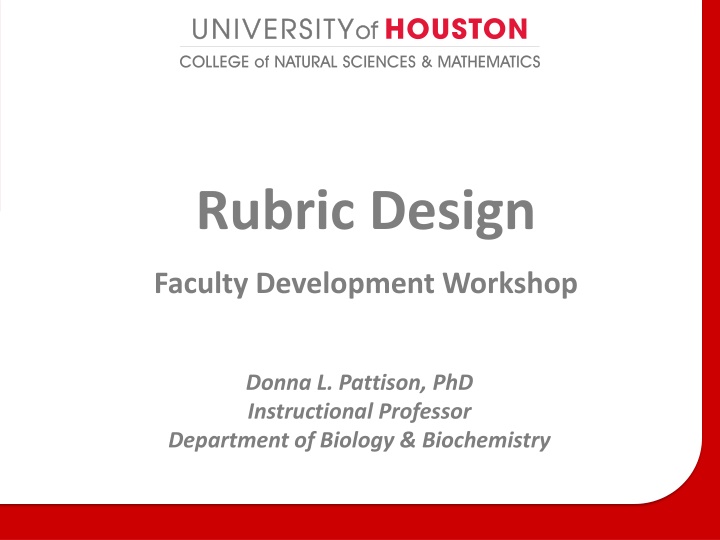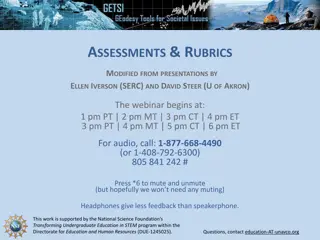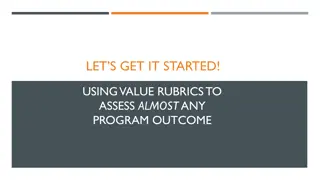
Rubrics: A Comprehensive Guide for Faculty Development
Explore the essence of rubrics, their purpose, key differences with scoring checklists, and the significance of holistic vs. analytic rubrics in evaluating assignments. Learn about creating effective rubrics for student assessment and enhancing the educational process.
Download Presentation

Please find below an Image/Link to download the presentation.
The content on the website is provided AS IS for your information and personal use only. It may not be sold, licensed, or shared on other websites without obtaining consent from the author. If you encounter any issues during the download, it is possible that the publisher has removed the file from their server.
You are allowed to download the files provided on this website for personal or commercial use, subject to the condition that they are used lawfully. All files are the property of their respective owners.
The content on the website is provided AS IS for your information and personal use only. It may not be sold, licensed, or shared on other websites without obtaining consent from the author.
E N D
Presentation Transcript
Rubric Design Faculty Development Workshop Donna L. Pattison, PhD Instructional Professor Department of Biology & Biochemistry
Evaluate the quality of this assignment: The assignment: You will write a 10 page research paper on a topic from the list below. The paper should be double-spaced with 1 margins using a Times Roman font. A minimum of 10 references is required. Systemic acquired resistance in plants vs the hypersensitive response The role of abscisic acid in seed dormancy and germination The role of red and blue photoreceptors in plant development
What is a Rubric? Rubric: A descriptive guide, usually in the form of a matrix that provides scaled levels of achievement or understanding for a set of criteria or dimensions of quality for a given type of performance (paper, oral presentation, teamwork) Adapted from Allen, D. and Tanner, K. (2007) Transformations: Approaches to College Science Teaching. W.H. Freeman Scientific Teaching. Chapter 7, p. 83.
What is the difference between a rubric and a scoring checklist?
What purpose does a rubric serve? 1. Communicate clear expectations 2. Aid student with self-reflection and self- evaluation of work. 3. Provide feedback 4. Evaluation: assignment level or learning outcomes across a department or university (i.e. University Core). 5. Criterion referenced rather than norm- referenced
Holistic vs Analytic Rubrics Holistic Provide a single score based on overall impression Analytic Provides a score for each characteristic Quick scoring More time consuming Provides fast snapshot Detailed feedback
Holistic Rubric http://manoa.hawaii.edu/assessment/howto/rubrics.htm
Analytic Rubric http://cosm.sfasu.edu/docs/Rubrics/Core/FINAL%20ORAL%20AND%20VISUAL%20COMMUNICATION%20VALUE%20RUBRIC.pdf
Elements of a Rubric 1. Performance elements: major attributes on which the work will be evaluated 2. Category scale: Quality classification 3. Descriptors: Description of the characteristics of the work that must be present at each quality category.
Typical Scales poor-good-excellent-superior beginning-basic-proficient-advanced-outstanding Unacceptable-developing-acceptable-exemplary Below expectations-meets expectations-exceeds expectations seldom-sometimes-usually-often Rarely-sometimes-often-almost always http://www.unk.edu/uploadedFiles/academicaffairs/Assessment/Training/Developing% 20Rubrics.pdf and http://uwf.edu/cutla/rubricdevelopment.cfm ; retrieved 3/20/2014
Choice of Scale: 3, 4, 5, 6 levels?! What s best?
Choice of Scale: 3, 4, 5, 6 levels?! What s best? There is no right answer! Some argue that even numbered scales are best as it forces the user to select between a proficient and a not proficient level. Others prefer an odd numbered scale because it allows for a neutral middle answer.
Steps to Developing a Rubric 1. Identify what you want to assess. 2. Identify the characteristics or dimensions (rows). 3. Identify the scale (columns). 4. Create descriptions for each characteristic and scale level. 5. Test rubric. 6. Revise.
No need to reinvent the wheel. Check what s available online and adapt it. Use rubric builders: http://rubistar.4teachers.org/ http://www.rubrician.com/science.htm






















